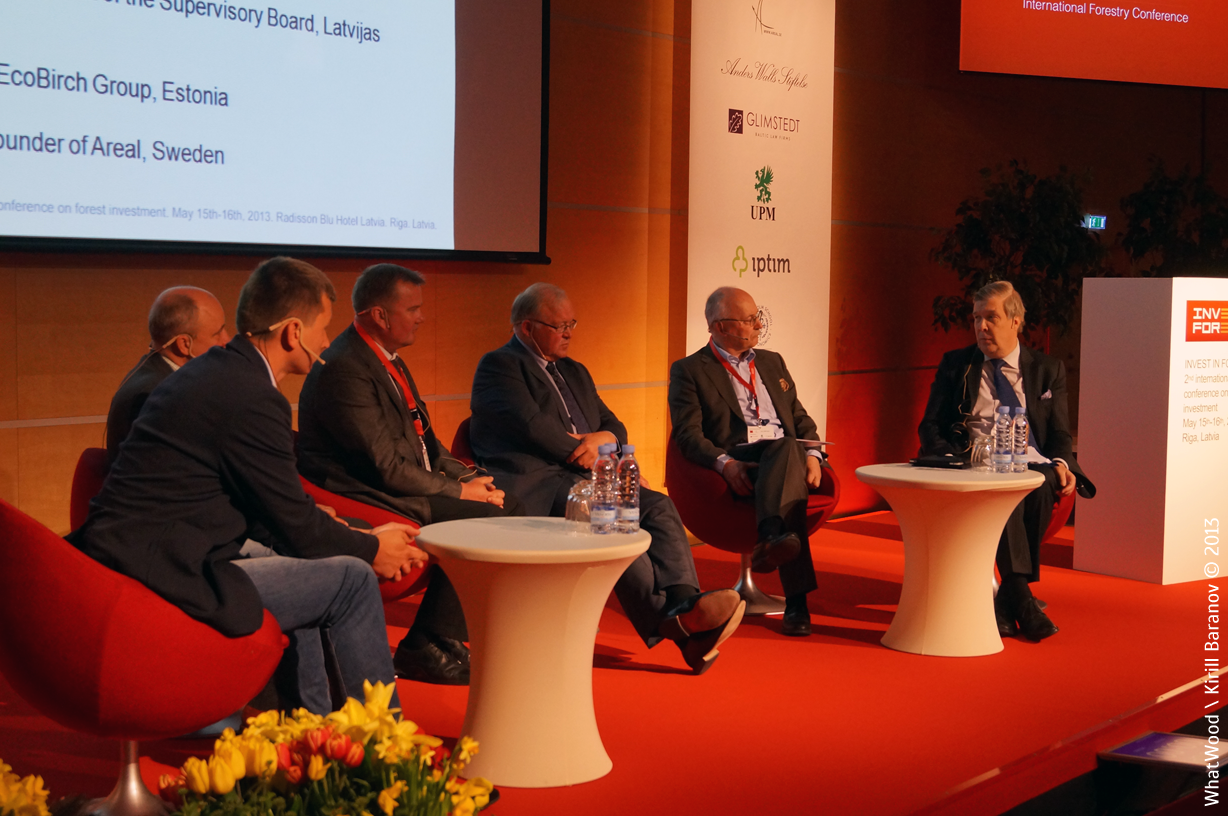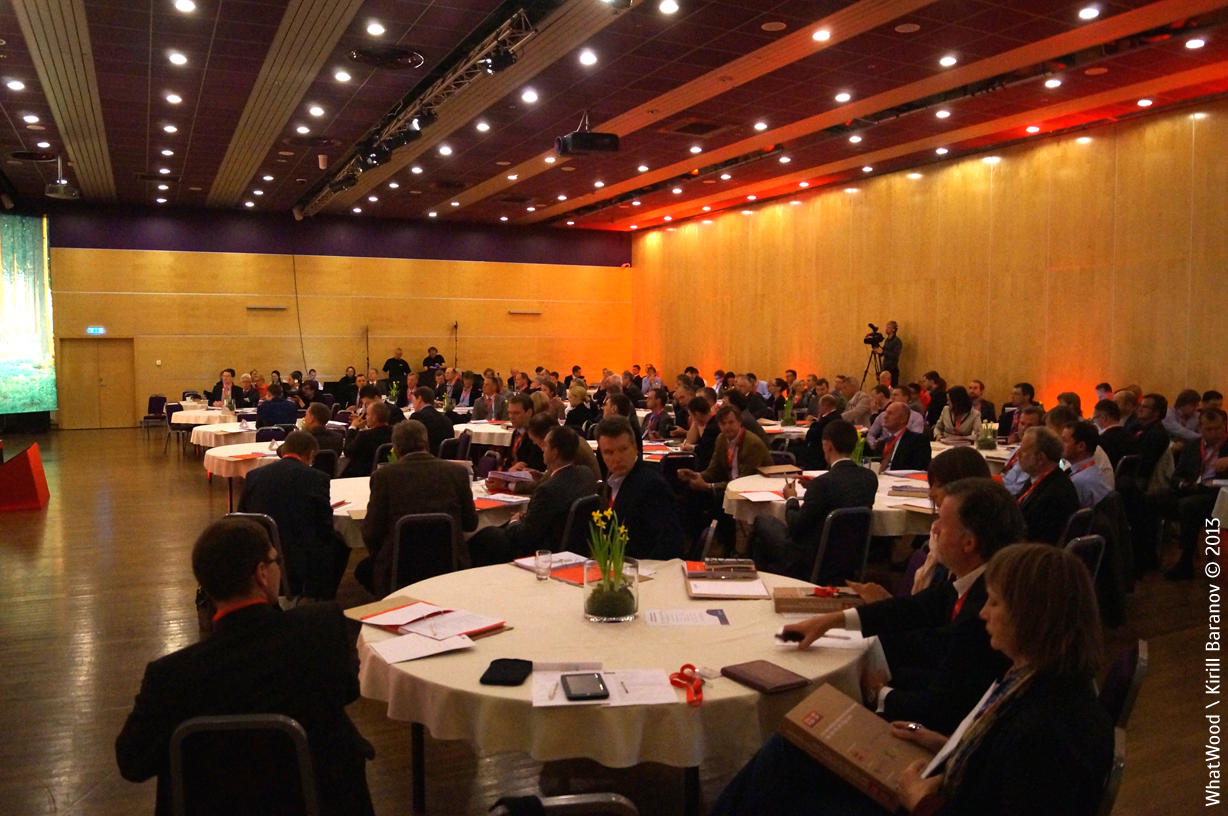50 ideas of 2nd Invest in Forest conference
Following the 2nd Invest in Forest conference held in Riga on May 15-16, 2013, WhatWood News & Analytics presents a collection of thoughts expressed by the event speakers, from analytic outlooks to expert opinions and ideas for the forest industry.

Goran Persson, Sveaskog, Chairman of the Board (Sweden), ex-Prime Minister of Sweden:
“Capacity is not only volume but also value, so I wouldn’t say that capacities are totally moving from Europe to Brazil or China. This process will end. New European products are extremely profitable. The matter of raw materials is open, but the industry is OK”.
“Managing forests only on the national level is a mistake”.
“I have been a prime minister, now I am a farmer and forest owner and proud to say this. There are 13 million farmers in Europe, a well-organized power. Then, there are 16 million forest owners, and I would say it’s not so organized. I fear the situation in Europe when farmers join with NGOs. What if farmers in Europe say: we have enough resources to produce bioenergy, why not save the forests?”
“Don’t ever think that Euro is a fiasco. Many companies suffer from currency fluctuations. That’s why Eurozone should be expanded, we welcome Latvia”.
“Climate change isn’t only a threat, it’s an opportunity to modernize the forest industry”.
“Let’s say that I’m optimistic in long-term. We’ve seen this before, we’ll be over it. The problem is that industries that should make research and development are not well-positioned to do this. So the next generation of products is not prepared for, is not invested in”.
“Emissions trade isn’t solving the environmental problem”.
“Investments in forests might possibly solve euro debt problem. Also, few people now say that inflation may come. In this case, it would be wise to invest in real estate and forestland. Especially for pension funds”.
Andris Strazds, Nordea Bank, Senior Economist (Latvia):
“Export will cease to be growth driver for Baltic forest industry in short term. Most important trade partners are not among the most vulnerable economies, but a prolonged period of weak external demand is a key risk. Household spending is increasingly important to maintain growth in the Baltics in the short term”.
“Stepping into Eurozone will bring stronger confidence and lower interest rates, as well as increased trade with other Eurozone countries. Moreover, important investment decisions concerning the future of the EU that would also affect Latvia are increasingly made at the Eurozone table. So if you are not at the table, you are on the menu. Latvia choses to be at the table”.
“The loud statements of government about foreign investments do not show hostility, they might be due to the pre-election period”.
Juhani Toivonen, Bergvik Skog, CFO (Sweden):
“Fast raw material growth is a competitive advantage of Latin America”.
Rainer Haggblom, Forest Company, Chairman (Finland):
“Productive forest is the cornerstone of profitable industry”.
“We need new big business, which is energy I believe. Energy is a regional business by far”.
“Woodworking is very diverse now in terms of products”.
Karl Danielsson, Areal, Founder (Sweden):
“Sawmilling is Nordic’s growth point and competitive advantage of the region which we should take care of”.
“70s also were a catastrophe for Nordic forest industry, but low wood prices led to pulp & paper industry boost”.
Hakan Ekstrom, Wood Resources International, President (USA):
“Lumber export from Russia to EU didn’t boom after log export tax imposed. Deliveries somehow increased to Asia, but fell to Europe, so it didn’t work for North-West Russia. Internal production in Russia didn’t boom either, so log export duty was a mistake. This is what Ukraine is now going to repeat”.
“US South prices are stable, while US North-West are less stable, as they rely very much on exports”.
Gert Rahnel, Metsagrupp, Manager (Estonia):
“Hardwoods, especially birch, are not much used resources in the Baltics, except for pulpwood. I think it’s time further processing to come from Scandinavia to Baltics”.

Dennis Neilson, DANA Ltd., Owner (New Zealand):
“China is the largest importer of logs and second largest importer of lumber. Softwood log import sources have changed dramatically, but Russia is still the largest single supplier. Huge increases have recently happened from New Zealand. Canada is the largest supplier of softwood lumber to China, with a 45% market share in 2012, followed by Russia at 39% and the USA at only 5%. China’s hardwood chip imports jumped from 1 million tons in 2008 to an estimated 7.1 million in 2012 with 89% coming from Southeast Asia”.
“Pulp shipments to India grow at a rapid pace, but from a small base”.
“There are only two nations that can invest $1 in Russian timberland and at least return it – Russians and Chinese”.
“It’s risky to invest in Chinese woodland and especially shares of Chinese companies, experienced professionals lost hundreds of millions there”.
“One of the ways to take advantage of growing China’s demand for wood is to invest in countries focused on trade to China. Brazil specializes in pulp exports to China, Chile – in chips, lumber and pulp, Australia in woodchips, New Zealand in logs and lumber, East Africa in chips and logs exports to the Chinese market”.
“Early movers are making good returns in Cambodia, there is a rapidly changing situation there. Vietnam also has very low costs and close proximity to China”.
“Some pulpwood species rotations may be 6-7 years and even 2-4 years in Vietnam and Thailand. Short rotation coppice biomass can also have 3-4 years of rotation”.
“As Dan Akerson, GM’s Chief Executive said, I’m sure China will do what is best for China. But you ignore China at your own peril”.
Thomas Lindeborg, Nordic & Baltic Property Group, Owner (Sweden):
“Role of non-monetary factors in timberland evaluation in the Baltics will increase to the Scandinavian level”.
“With forestland investments, timing is easier. If you have a leaking roof, you can’t wait for one year, with thinning it’s possible”.
Michael von der Tann, German Forest Owners Association, Member of the Board (Germany):
“Annual turnover of German wood-based industry makes up €181 billion”.
“There is very poor internal supply and high demand for pine in Germany”.
“Timberland value in Germany is €6-20 thousand per ha, depending on quality, growth stock, hunting possibilities, proximity to urban areas and markets”.
“Companies do not own forests in Germany, mostly it’s private persons and state”.
“There is no clear-cut, no short rotation possibility in German forests. Investment return in German timberland is around 1-3%, so it’s a conservative market”.
“Wood prices in Germany are linked to international markets”.
Lars-George Hedlund, Bergvik Skog, Managing Director (Sweden):
“Wood plantations are a cost effective way to produce additional raw materials and to even out the age structure of the forest holdings”.
“In the Northern hemisphere, growth rate is twice as lower as in the Southern, about 25 m3 per year. Hybrid aspen gives 20 m3 with 20-25 years of rotation, poplar – 25-30 m3 with 15-20 years of rotation”.
“Gross revenue on poplar plantation wood in the North is €28 per cu m or €560-840 per ha annually”.
“Having 200 000 ha of plantations, Latvia could have additional 4-5 million m3 of raw materials – a 50% increase from current level. Imagine what effect it could have on manufacturing industry and converting and exporting of biofuel”.
“It’s a shame that we are not replacing Russian gas with wooden biofuel”.
“Italy is producing massively veneer from poplar timber. It is said that 75-80% of poplar timber is used for veneer production globally”.
“Hybrid aspen has slightly better wood market with more applications. But it is attractive for wild animals and needs fencing which is very costly. Poplar is a robust species and less attractive to animals”.
Lars Winter, Domsjo Fabriker biorefinery, CEO (Sweden):
“For graphic paper producers, innovative products like bioethanol or specialized pulp are an opportunity to maintain value”.
“Whatever can be made of oil, can be made of trees. I don’t say it’s easy to make tyres out of cellulose right now, but at least we can make such products more sustainable”.
Riitta Vaisanen, UPM, Sales Manager (Finland):
“Finnish forests provide a typical 3-4% net yield when managed properly”.
“We’re selling forests to buy new forests in areas where we need it, closer to our own mills, not necessarily in Eastern and Central Finland, as earlier. We don’t need to secure wood supply anymore, this matter is not very acute. We also need funds for developing new products”.
Anders Portin, Indufor, Senior Consultant (Finland):
“One third of all timber, 500 million m3, is plantation-grown”.
Felix Karthaus, HD FestForest, Managing Director (Estonia):
“Within several years, the Baltics has built its forest industry with the help of Germany, Finland and Sweden. Stora Enso has formed a five-sawmill greenfield empire in two years”.
“We found people who lived close to forest plots, paid them with money or firewood so that they survey the forestland, that’s how we fought illegal logging”.
 Timber industry research & analytics
Timber industry research & analytics 